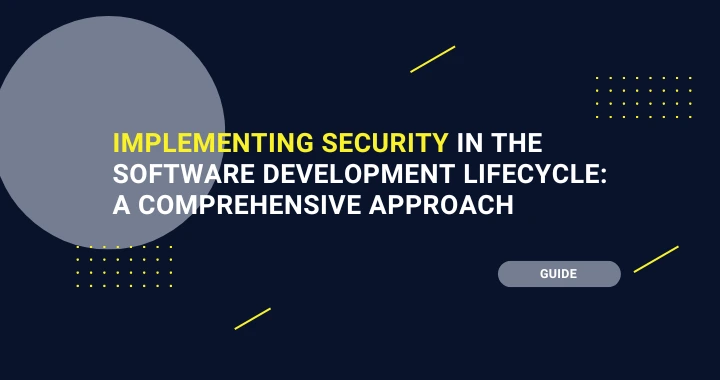- Industry insights
- 24 Feb 2025
Implementing Security in the Software Development Lifecycle: A Comprehensive Approach
Learn how to implement software security throughout the software development lifecycle with a comprehensive approach



Table of contents
Contributors

Introduction
In software development, security is not an option, but a priority. One of the first questions a user asks before accessing an application is: “Is it safe?”. But users are not the only ones who can suffer from a vulnerability. Both the developers and especially the company behind the application can end up in a very unpleasant situation – from loss of user trust to serious legal and financial problems.
In today’s article, we’ll discuss how to implement security in the software development process cycle to protect your applications and ensure that their users can safely browse them.
What is secure SDLC?
Software Development Life Cycle (SDLC) is the process by which software is created, from the initial idea to the release, involving 7 clear steps: planning, requirement analysis, design, development, testing, deployment, and maintenance.
On the other hand, as you may have already guessed, the Secure SDLC requires a more careful consideration of security, being integrated into every step of the process. In the classic SDLC process, security is often dealt with at the end, but in the secure SDLC, each step is built with the application’s security risks in mind.
DevSecOps implementation vs SSDLC
DevOps is a methodology that combines a set of software practices intending to deliver software faster and with better quality, promoting process automation and continuous integration.
In DevSecOps, the methodology assumes a continuous focus on security, which is automatically integrated with all the phases of the development process.
SSDLC is used to create safe and secure software, and DevSecOps is used to maintain security throughout the application lifecycle.
How can security be integrated at every stage of the development process?
Planning and Security Requirement Analysis
Before actually writing the code, an analysis part is needed to define the software’s security requirements and establish a plan to manage risks and potential vulnerabilities.
Designing with a Focus on Security
Once the plan has been created, you can move on to creating the architecture. When building it, possible attacks and vulnerabilities must be considered, along with applying security principles in the design. An example here is the Defense in Depth principle which involves implementing multiple layers of security controls so that if one layer fails, others can still protect the system.
Implementing Security Measures in The Development Phase
When software implementation starts, make sure you apply secure coding practices and integrate security measures like encryption, authentication, and logging to safeguard your software against potential attacks. You should utilize tools such as code reviews and unit tests to verify both the quality and the security of your code.
Testing The Security Too
Once you have finished creating your software, you need to check it to make sure it is secure. This involves ensuring there are no bugs or vulnerabilities that could affect its operation or leave it open to attacks. To do this, use different testing methods such as penetration testing, as well as specific tools that do these tests automatically (OWASP ZAP, Burp Suite, Nessus).
Ensuring Secure Deployment
When you’re ready to launch, make sure you do it securely. This involves properly configuring the software and its environment, using secure protocols. Also, make sure you have an incident response plan in place in case of attacks or post-launch vulnerabilities.
Maintaining security
A lack of active software maintenance is a common security mistake. It is important to periodically review security requirements and software structure to implement various updates. Without regular updates and reviews, your application becomes vulnerable and can be exploited by hackers.
The Most Common Security Risks
Code with vulnerabilities
Errors in code create vulnerabilities that can be exploited by hackers. Follow secure coding principles and use code reviews and static analysis to detect vulnerabilities.
Unsafe password storage
Incorrectly stored passwords can be stolen and used in attacks. Do not store passwords in clear text and make sure you use secure hashing algorithms, like bcrypt or Argon2.
Outdated software
Old apps stop receiving security updates and may have vulnerabilities that are not patched, making them easy targets for attacks. Upgrade old software with modern technologies and architectures and perform regular security tests to identify and fix potential vulnerabilities.
Other errors may also occur. Let’s explore them in the next section, in which we will present real-world examples of security errors.
Real-world examples of security errors
Yahoo – Insider Threats
A former Yahoo employee has been accused of stealing confidential information to sell to a competitor, The Trade Desk. The former employee downloaded 570,000 files, including the advertising engine’s source code, transferring the data to personal external devices. This type of error falls into the insider threats category. To avoid it, solutions such as real-time user activity alerts or implementing continuous user activity monitoring are needed.
Mailchimp – Social Engineering & Phishing
In January 2023, a group of hackers pulled off a social engineering attack, manipulating a Mailchimp employee into revealing his credentials. The consequences were the compromise of at least 133 user accounts. Such errors can be prevented by constant training of employees on these types of attacks, as well as by implementing a two-factor authentication (2FA) system.
NASA & Jira – Misconfiguration
NASA had a security problem due to a misconfiguration in a tool used for project management (Jira). Due to an incorrect setting, data that was supposed to remain confidential was exposed to the public. It is therefore very important to check the privacy settings of your applications and make sure that sensitive information does not end up in the hands of those who should not see it.
Tik Tok – Misuse of the digital platform
During the 2024 Romanian election campaign, the Recorder group conducted an experiment highlighting the TikTok platform’s vulnerabilities and how its algorithm can be manipulated by changing some parameters in the code. The team created a fictitious character, an imaginary candidate for the Prime Minister of Romania, demonstrating how easily the public’s perception of him can be influenced by modifying the code. This situation reminds us that in software development, security is not only about protecting the code against attacks but also about implementing measures to prevent misuse of digital platforms.
Proactive & Reactive Security Measures: Best Practices
Proactive measures are those that are taken before a security problem occurs, while reactive measures are those that are taken after a security problem has occurred. In the following table, we emphasize proactive measures, as they are essential to prevent security problems and to avoid the need to implement reactive measures.
| Proactive Security Measure | Description | Tools |
| User education and training | Ensures that employees are aware of common security risks (e.g., phishing, social engineering) and know how to act securely. | KnowBe4, Cofense (phishing simulations, security training programs) |
| Vulnerability scanning | Identifying system or application weaknesses before they are exploited by attackers. | Nessus, Qualys (scan for vulnerabilities in networks, systems, and applications) |
| Penetration testing | Simulating real-world cyberattacks to find exploitable vulnerabilities in your infrastructure, applications, or networks. | Burp Suite, Kali Linux, Metasploit (hacking tools for penetration testing) |
| Data encryption | Only authorized users can decrypt and access sensitive data. | VeraCrypt, BitLocker (encrypt data on hard drives, communications, and databases) |
| Static Application Security Testing (SAST) | Analyzes source code for security vulnerabilities before the application is even run, identifying potential flaws during development. | Checkmarx, Fortify (tools to analyze code for vulnerabilities during the development process) |
| Threat intelligence feeds | Provides real-time information about emerging cyber threats to help organizations proactively defend against them. | CrowdStrike, FireEye, ThreatConnect (threat intelligence platforms that track and analyze cyber threats) |
Here’s a list of reactive measures to keep in mind:
- Analyzing how the breach occurred.
- Immediate actions to limit damage after an attack.
- Observing networks to detect suspicious activity.
- Informing affected users and authorities about the breach.
- Blocking IPs involved in attacks.
- Reviewing the attack to prevent future occurrences.
Conclusion
In conclusion, this article aims to serve as a guide for implementing security throughout the entire software development lifecycle. Every step of the process, from planning and analysis to maintenance, must include clear and precise security measures. Finally, don’t forget that prevention is always more effective than reaction to an attack, which makes the following saying true – it is better to be safe than sorry.
Secure your software development process today! Contact us now to learn how we can help you implement robust security measures at every stage of your development lifecycle – Get in touch with us!
Outsourcing vs. In-house Development: Why Romania is the Best Middle Ground
The Talent Pool in Romania: Why Global Companies Hire Developers Here
The Real Cost of Software Outsourcing: Why Romania Offers the Best ROI